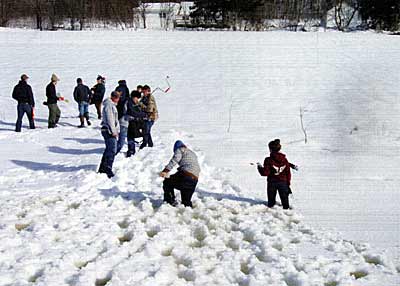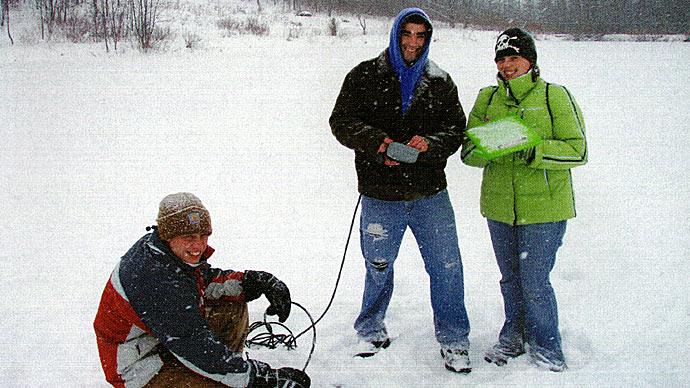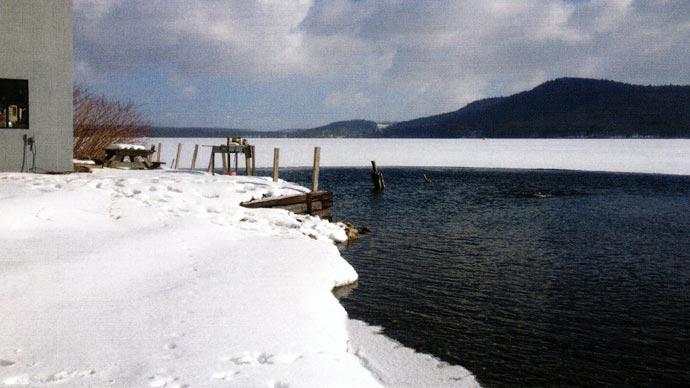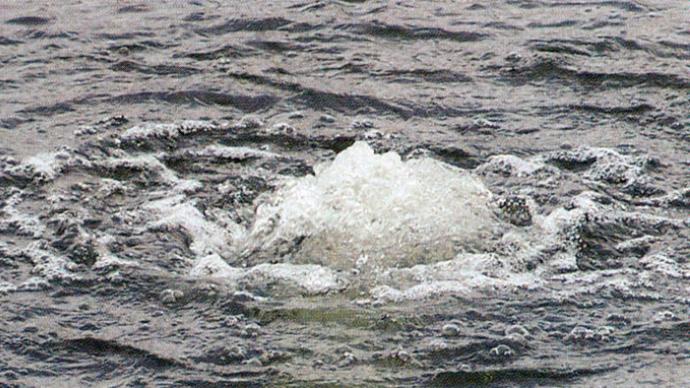
Winterkill.
That's a bad word among pond owners! What is winterkill? Why does it happen? Why doesn't winterkill happen every winter? Why doesn't it happen in a pond near another pond where it did happen?
Winterkill is the die-off of fish in a pond during winter, under ice. By learning why winterkill happens and understanding the basic science behind it, we can understand why it sometimes happens and why different ponds behave differently in winter.
First, a little more about winterkill. Simply put, a bunch of fish die all at once during winter. Sometimes, all fish in a pond will die, but that is not always the case. It is also possible for some fish to die and others to live. When a partial winterkill happens, it is likely that some species were more likely to live than others. For example, bullhead catfish are much more likely to live through a moderate winterkill than trout. This is because bullheads have different requirements to live than trout; trout require large quantities of oxygen in the water to live, bullhead can live in much harsher conditions with much less oxygen and lousy water quality. Think about it this way; ice cream requires extremely special conditions to remain ice cream, Pre-packaged lunches with lots of preservatives can remain as such through almost any conditions. Trout are ice cream; bullheads are prepackaged lunches. The severity of the winterkill will determine if a few fish, many fish, most fish, or almost all fish die off. But the ice cream will melt long before those lunches are no longer.... edible?
How does winterkill happen? A pond has oxygen dissolved in the water (just like sweet tea or Snapple has sugar dissolved in it). When the pond freezes over (gets covered by ice) in the winter, it is sealed off from the atmosphere and no more oxygen can get into the pond without help from plants and photosynthesis. Even though the pond is sealed off from the atmosphere, fish in the pond still need dissolved oxygen to live. This means fish continue to use oxygen stored in the ponds' water. Eventually, stored oxygen can be used up, leading to winterkill. Fish suffocate.
There are three common variables, or circumstances and events, that play out over long winter months and sometimes work together to cause a winterkill. These variables are; how long the pond is iced-over, how deep the pond is, and how productive the pond is (how much vegetation is in the pond or if it has an algae bloom). The longer the pond is iced over, the longer the pond goes without getting more oxygen dissolved back into the water, the more likely it will winterkill. The depth of the pond matters because deeper ponds have a bigger savings account of oxygen. Deeper water means more stored oxygen, which means the pond can go longer without new additions of oxygen. Lastly, large amounts of vegetation will increase a ponds chance of winterkilling. In the fall, much of the vegetation in a pond will die, like the leaves falling off a tree in the fall. Over the winter, this dead vegetation will decompose (rot, decay) and the process of decomposition consumes (uses) oxygen. This means the process of decomposition will also use up the stored oxygen from the pond, just like fish use the oxygen that is stored in the pond. Plants that don't die will continue to photosynthesize, producing oxygen, unless the ice isn't clear, which is most common. In that case, living plants will use oxygen and produce carbon dioxide, which makes oxygen continue to decrease, adding to the problem.

You might ask, "Why are deeper ponds safer from winter kill but not bigger ponds?" Why is depth more important than the volume (amount) of water? Great question! Imagine two ponds with the same volume of water, but one is big and shallow and the other is small and deep. The small, deep pond is like a glass of water and the
large shallow pond is like the same glass of water onto a cookie sheet. In ponds, lakes, and oceans, the shallow water area where light is able to reach the bottom and plants are able grow is known as the littoral zone. Shallow ponds may even have bottoms completely covered in vegetation because light can reach the bottom of the entire pond during warmer months. However, deep ponds tend to have small littoral zones and much less vegetation. Therefore, deep ponds have lower plant productivity than shallow ponds because sunlight does not reach as much of the bottom of a deep pond, and plants cannot grow in the deep water of deep ponds.
The three variables related to winterkill, duration of ice cover, pond depth, and productivity (amount of vegetation) work together. This can help explain why one pond may winterkill and a neighboring pond does not. Maybe one pond is deeper than the other. Possibly local physical factors like wind, sunlight, and temperature may cause one pond to freeze later in winter than the other, shortening the duration of ice-over. The land around a pond might lead to an increase in productivity; fertilizer, septic run-off, and agricultural runoff all are known to increase plant growth (productivity) of nearby ponds. New ponds tend to be less productive than old ponds and ponds tend to get shallower over time; it is possible that a pond will winterkill more often as the pond ages. A pond managed for large, sensitive game fish species may be more likely to experience winterkill than a pond full of bullhead catfish (ice cream and preservative-loaded lunches).
Nature can sometimes be very mysterious but understanding the primary factors behind winterkill can help us understand how subtle differences in a pond or a winter season can determine whether or not winterkill happens.
Christine Cornwell is a horse trainer who lives in upstate New York with her husband and son. She has worked for the New York State Department of Environmental Conservation and —— " was a high school science teacher. Sharing her love of a healthy, natural world is a daily passion.
Reprinted with permission from Pond Boss Magazine



